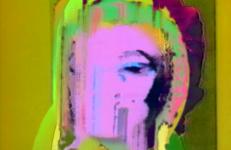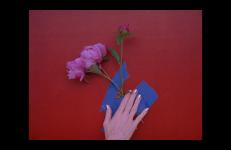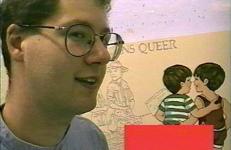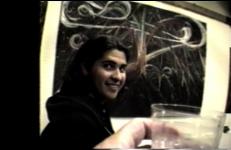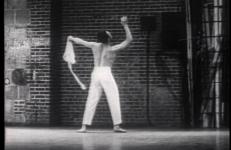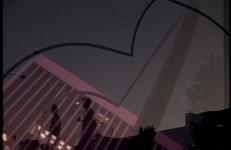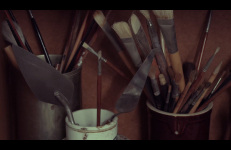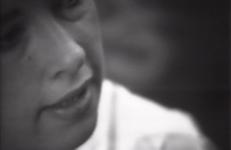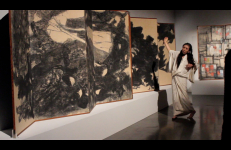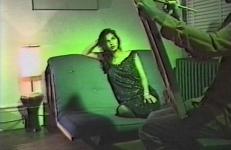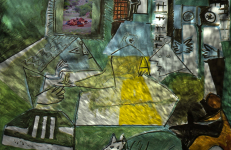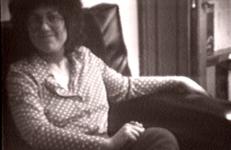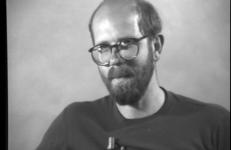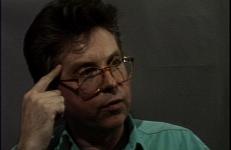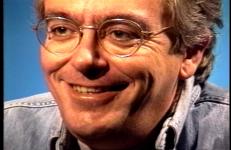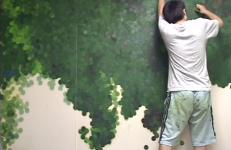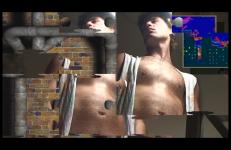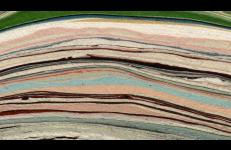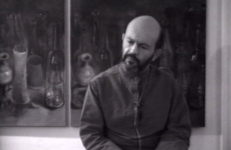2001 Colours Andy Never Thought Of transforms Warhol’s infamous screen prints of Marilyn Monroe through a process of color manipulation. The viewer witnesses a flurry of changing tones, colors, and shades in a postmodern nod to the scratch genre that Barber came to define.
Painting
3 Peonies is a brief, poetic 16mm film of a simple sculptural action. What becomes apparent is the humor possible in material interactions and the tender and sometimes melodramatic symbolism of cut flowers. The reverence for beauty ends up pointing towards the abstract expressionism and color field painting of high modernism that, in many cases, eschewed the banality of such ‘natural’ beauty.
A brief visit with a graduate student in the painting department of the art college where Kuchar teaches and the discussion that follows the unveiling of his work. Stroll through a gallery of acryllic-rendered innocence gone awry and the yo-yo generation in heat.
A young painter, and his somewhat slower roommate, talk of paranormal occurrences in a room of charcoal canvasses and ephemeral renderings. Eavesdrop on the improbable and the impossible (BUT TRUE!).
This video features California artists: drawer and painter Deanne Belinoff, sculptor and poet Sana Krusoe, wood relief carver and painter Palema Holmes, and New York-based video artist Shirley Clarke.
The Artists: Part 1 was produced in concert with the exhibition Four Solo Exhibitions at the Long Beach Museum of Art in 1988. The artists are introduced by LBMA’s senior curator Josine Ianco-Starrels. The video presents and contrasts the diverse styles, media, and personalities of these four women artists.
This video profiles the work and insight of California artists: sculptor, painter, and installation artist Laddie John Dill and painter and sculptor Clark Walding. It also includes a mini-documentary on Tony Delap’s The Big Wave, a public art sculpture that crosses Wilshire Boulevard in Santa Monica.
Luis Cruz Azaceta (b.1942) creates paintings and mixed media works which use the recurring theme of the displaced individual. Marked by his own exile from Cuba—he emigrated to the U.S. in 1960, in the wake of Castro’s take-over—the artist realized that home is something he carries with him from place to place. Through his piercing expressionism, Azaceta depicts the frailty of human existence in a world full of social anarchy, historically mandated violence, and natural chaos.
An unorthodox essay film on the renowned but controversial painter, Philip Guston. Ballad interweaves Guston’s biography, influences, and philosophical approach to art with Cohen’s deeply personal engagement with the man and his work. Balancing elements as disparate as Krazy Kat cartoons, the 19th Century Russian author Babel, and Guston’s lifelong grappling with racism and injustice, the film is an unusual critical immersion and a free-wheeling celebration of painting’s radical potential.
Jennifer Bartlett (b. 1941) is a writer and painter who makes large paintings with enamels on fabricated panels. She uses an overall grid structure on which she repeats images in a variety of styles ranging from lyric abstraction to childlike representation. Near the end of this interview with Kate Horsfield, she reads the chapter “Dreaming” from her book The History of the Universe (1985). “I decided: 1) I didn’t want to stretch a canvas again, 2) I wanted to be able to work on a lot of things at once. I didn’t want to exercise my own taste, which seemed boring and hideous. I wanted something modular, a constant surface."
A historical interview originally recorded in 1976, edited in 2010 with support from the Lyn Blumenthal Memorial Fund.
Jeremy Blake (1971-2007) used digital media to create works that function on a flexible spectrum between being more painting-like or more film-like. He created continually looping digital animations with sound to be projected or presented on plasma screens. Blake often began by making the digital C-prints, which he conceived to be somewhat like paintings; if the imagery and idea of one of these works lent itself as such, he might extrapolate from and expand on it to begin creating a digital animation, which could range from 3 to 20 minute repeating loops.
For the November 13, 2015 opening of the Hiroshima Panels by Iri and Toshi Maruki at Pioneer Works, Eiko performed her solo in honor of the Hiroshima Panels and their creators. Japanese-style painter Iri Maruki, born in Hiroshima, and Western-style painter Toshi Maruki, who went into Hiroshima city just three days after the bombing. The artists decided to paint the panels together, which illuminate the human experiences of the Atomic Bomb. They spent 30 years painting the fifteen Hiroshima Panels, six of which were on display at Pioneer Works in Red Hook, Brooklyn.
Phyllis Bramson (b.1941) is a Chicago painter whose post-imagist style emphasizes content and the deeply personal. Bramson’s paintings are private scenarios that include figures (or performers) who carry out highly charged activities with strong psychological meaning. They perform in highly theatrical, Oriental settings of almost cubist space and acid greens, yellows, and reds.
Artists with brushes need light to paint a picture, but human feelings function just as well in the dark.
California-based painterJoan Brown (1938-1990) attended the California School of Fine Arts (now the San Francisco Art Institute). Brown has long been recognized as one of the most important artists to emerge from the creative milieu of the San Francisco Bay Area of the late 1950s. She created a body of work distinguished by its breadth and personal vision. Brown’s style incorporated abstract expressionism and figurative painting. One of California's pre-eminent figurative artists, she died in at the age of 52, in India.
Roger Brown's (1941-1997) quirky, stylized paintings were influenced by such disparate sources as comic strips, hypnotic wallpaper patterns, medieval panel paintings, and early works of Magritte. His work is epitomized by a series of claustrophobic urban scenes with their drop-curtain-like gray clouds and cardboard-box apartment buildings, suggesting an amalgamation of boyish enthusiasm for model making and adult despondency. In 1996 he donated his apartment, complete with all of his belongings, artworks, writings, and automobile to the School of the Art Institute in Chicago, where it is on public display.
Judy Chicago (b.1939) creates large-scale, collaborative artwork has brought greater prominence to feminist themes and craft arts such as needlework and ceramics. Her most famous work, The Dinner Party (1979), was an enormous collaboration with hundreds of volunteers including ceramicists, china painters and needleworkers. The monumental finished piece has place settings for 39 mythical and historical famous women, writing them back into the heroic history usually reserved for men. Earlier in her career, Chicago was part of the Finish Fetish movement within Minimalism.
Chuck Close (b.1940) has been a leading figure in contemporary art since the early 1970s. As a young artist in the mid-’60s, Close turned away from the model of Abstract Expressionism to develop a simple but labor-intensive working method based upon repetition and small color elements. Denying himself expressive gesture, Close builds shapes and tonal variations within a working grid that provides the structure for large-scale, close-up portraits. Close’s formal analysis and methodological reconfiguration of the human face have radically changed the definition of modern portraiture.
John Arthur Clark (1943-1989) was born in Yorkshire, England. He attended Hull College of Art, receiving a National Diploma in Art and Design (N.D.D.) in painting. From 1966 to 1968 he attended Indiana University, receving an M.F.A. in painting. From 1968 to 1978 he was a lecturer in Fine Art and Art History at Hull College of Art and Newcastle Polytechnic. He emigrated to Canada in 1978 and became coordinator of painting and drawing at the Nova Scotia College of Art and Design.
Spanish painter Chema Cobo discusses his early years of studying and creating art in Southern Spain. His career began in the mid-1970s, exhibiting at the Buades and Vandrés galleries, along with a generation of now-established artists. His work began showing outside of Spain in the ’80s. Cobo also talks about the ways that his Spanish background and identity have informed his work.
A historical interview originally recorded in 1994.
Satoshi Uchiumi, Japanese abstract painter, believes that the beauty of painting lies within paint itself. He has pursued beauty by painting thousands of colored dots. He has also become known for his ability to highlight the relationship between the artwork, the exhibition space, and the viewer.
A witch’s moon ignites an artist’s canvas with lurid colors that keep him from sleep in a city that is the subject for his brush. Disgusted with the spiritual emptiness of his paintings, he now seeks a landscape that will contain in it deeper meanings — one that offers “inner peace.”
Dad’s Stick features three objects that my father showed me shortly before he died. Two of these were so well-used that their original forms and functions were almost completely obscured. The third object seemed to be instantly recognizable, but it turned out to be something else entirely.
Jim Dine (b. 1935) first emerged as an avant-garde artist creating Happenings and performances with Allan Kaprow, Claes Oldenburg, and others in the early 1960s. Ultimately, he rejected the performances that led to his early success in favor of an introspective search for identity. Using banal objects as subjects for his paintings and prints, Dine displayed a growing sense of self-awareness.
Rackstraw Downes’s “observation” paintings, executed on-site at ponds, intersections, and baseball parks, began as a mischievous response to the dogma of style and modernist criticism.
“There was a tremendous intellectual back-up, essentially against a lot of the figurative painting being done in the ’60s,” Downes says in this interview with Robert Storr. “If I show my slides in an art school I’ll get, 'Your paintings are very nice but how can you go backwards from Cézanne?’”




